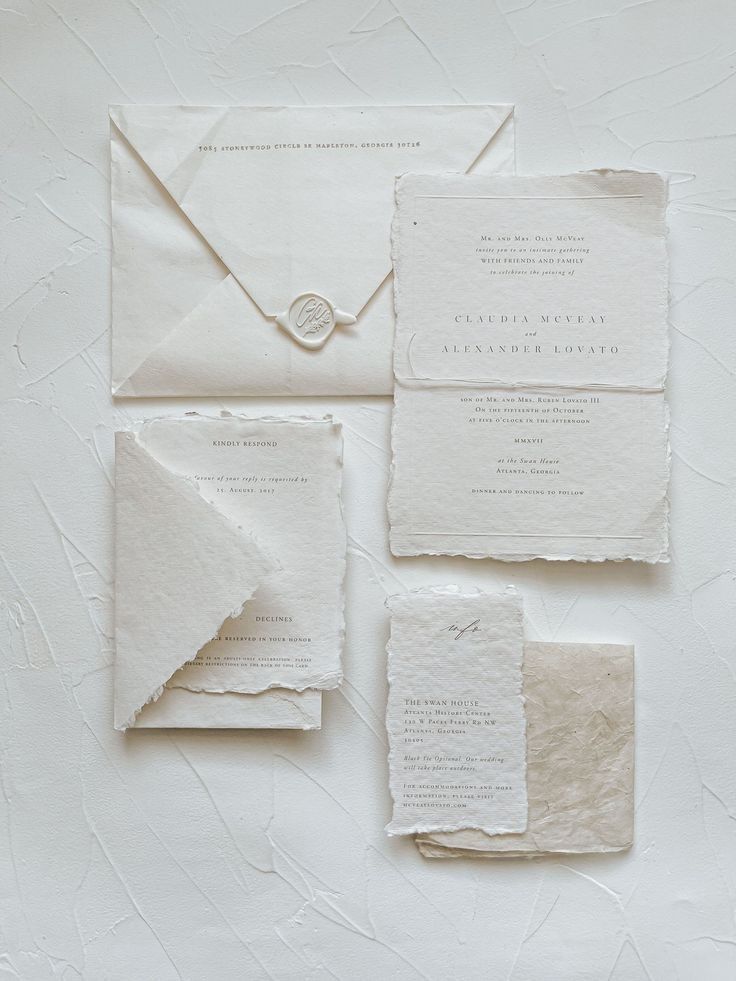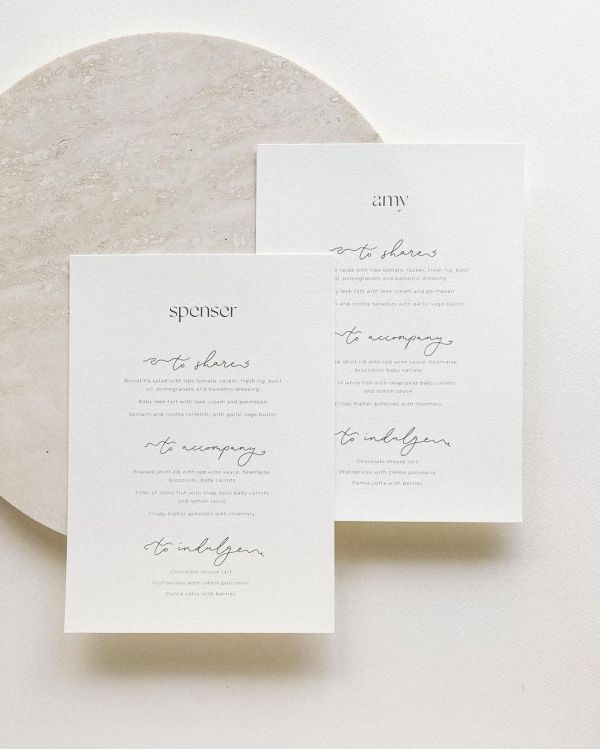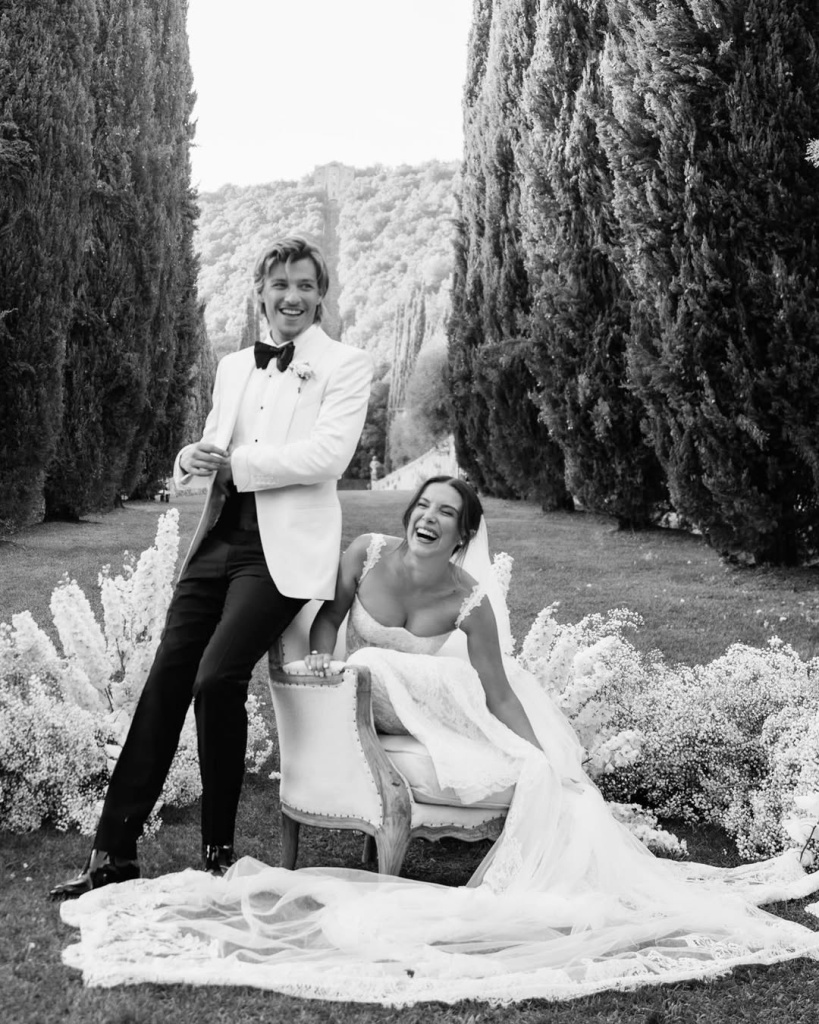Wedding Stationery Trends in 2025
- Author: Natali Grace Levine
- Reading time: 9 min 4 sec
- Publication date: 12/17/2024
- Updated: 01/07/2025
- Handcrafted Paper Poetry
- Sustainability Meets Luxury
- Architectural Minimalism
- Heritage Reimagined
- Textural Storytelling
- Chromatic Evolution
- Artisanal Calligraphy 2.0
- Interactive Elegance
- Bespoke Illustration
- Typography as Art
- Cultural Fusion
- Precious Metal Evolution
- Textile Inspiration
- Vintage Revival
- Smart Simplicity
In the ever-evolving world of wedding celebrations, stationery continues to serve as the first glimpse into a couple's love story. As we embrace 2025, the art of wedding correspondence has transformed into a beautiful fusion of timeless elegance and contemporary expression. Let's explore the enchanting trends in stationery in 2025 that are capturing hearts and setting new standards in the upcoming wedding season!

Handcrafted Paper Poetry
The resurgence of handmade paper has blossomed into an art form that speaks volumes about a couple's commitment to both beauty and meaning. Each sheet tells its own story, with deckled edges that whisper of artisanal care and embedded botanical elements that bring nature's poetry to life. Artisans are now creating these treasured pieces using centuries-old techniques while incorporating modern innovations.
Popular elements in handcrafted invitations include:
- Cotton rag paper infused with wildflower seeds native to the wedding location
- Pressed flowers collected from significant locations in the couple's journey
- Hand-torn edges treated with 24k gold leaf
- Natural dyes created from local flora
- Embedded dried petals from the bride's mother's garden
The process of creating these pieces has become an intimate part of the wedding journey itself. Many couples are participating in papermaking workshops, learning to craft their own invitation paper under the guidance of master artisans. This personal touch transforms what could be a simple invitation into a piece of art that carries the couple's energy and intention.


Sustainability Meets Luxury
The evolution of eco-conscious stationery trends in 2025 has transcended the simple use of recycled materials, blooming into a luxurious celebration of environmental stewardship. As couples embrace the delicate balance between luxury and sustainability, today's invitations have become masterpieces of innovative materials and conscious craftsmanship, proving that environmental responsibility and opulent design aren't just compatible – they're inseparable in the modern celebration landscape.


Architectural Minimalism
In the quiet spaces between lines and shadows, a new form of wedding stationery artistry has emerged. Drawing inspiration from the bold simplicity of modernist architecture, these invitations transform negative space into a canvas where typography dances with precision and purpose. Each element is carefully considered, and each line is deliberately placed, creating compositions that breathe with elegant restraint.
The sophistication lies in the subtle interplay of texture and light. Raised letterpress printing casts delicate shadows across pristine surfaces, while metallic foils catch and reflect light in ways that transform the invitation throughout the day. This interplay of light and shadow creates an ever-changing artwork that reveals new details with each glance.
The color palettes in these designs whisper rather than shout – soft whites warmed by candlelight, graceful greys that echo morning mist, and the gentlest touch of metallic accents that seem to float above the paper's surface. Some designers are pushing boundaries by incorporating architectural materials directly into their designs – thin veneers of marble, delicate sheets of brushed metal, or translucent layers that create depth through shadows.


Heritage Reimagined
The art of the family crest has undergone a renaissance, transformed by the hands of modern artists who understand that heritage is not just about looking backward, but about creating legacy. Today's couples are working with heraldic artists to craft personal symbols that weave together their distinct cultural traditions, professional achievements, and shared dreams for the future.
Digital rendering techniques have expanded the possibilities of these designs, allowing for intricate details that would have been impossible in traditional engraving. Yet many artists are choosing to blend these modern capabilities with time-honored techniques, creating designs that are first rendered digitally, and then transformed through traditional processes like wood blocking or hot foil stamping.






Textural Storytelling
The evolution of tactile elements in wedding stationery has transcended mere decoration to become a form of sensory poetry. Each invitation becomes a journey for the fingertips, telling its story through layers of texture that engage the senses and create moments of discovery. The physical act of exploring these invitations becomes part of the story itself, creating a deeply personal connection between guests and celebration.
Modern artisans have mastered the art of layering, creating invitations that reveal their secrets gradually. A velvet ribbon might lead to a letterpressed card, which opens to reveal a delicate overlay of hand-torn vellum, each layer adding depth to the narrative. The textures themselves carry meaning – rough-hewn handmade paper might represent the foundations of love, while smooth, polished surfaces suggest the refinement of time.
The interplay between different materials has become increasingly sophisticated. Papers of varying weights and textures are combined with elements like metallic threads, botanical specimens, and even small pieces of fabric from wedding attire, creating multi-sensory experiences that unfold like chapters in a story.


Chromatic Evolution
The language of color in wedding stationery has matured into a sophisticated dialogue of tones and undertones, where single colors are explored with the depth and nuance of a painter's palette. Gone are the days of flat, singular shades. Instead, colors are being layered and graduated with extraordinary subtlety, creating invitations that seem to capture the very essence of light and shadow.
Today's couples are embracing the poetry of monochromatic design, where a single beloved hue is explored through all its variations. A suite might begin with the palest whisper of sage on the outer envelope, deepening through various green tones until it reaches the richness of forest on the innermost card. This gradual intensification of color creates a sense of journey, of moving deeper into the heart of the celebration.
The psychology of color has taken on new importance in invitation design. Couples are choosing their color progressions not just for aesthetic appeal, but for the emotional journey they create.


Artisanal Calligraphy 2.0
The ancient art of calligraphy, one of the most enduring trends stationery artists embrace, has found transcendent new life in the digital age. Here, traditional craftsmanship meets innovative technology to create something entirely unprecedented, reflecting the harmonious marriage of past and present.
Beyond mere lettering, today's calligraphic designs weave a story of artisanal evolution among wedding stationery trends. They incorporate elements of movement and flow that suggest the dynamics of human relationships, creating an intimate dance between tradition and innovation. Words might sweep across the page like wind across water, or intertwine like lovers' hands, creating visual poetry that elevates the written word to living art.


Interactive Elegance
The concept of interaction has transcended simple mechanics to become an integral part of the invitation's emotional narrative. These pieces don't merely unfold – they reveal themselves in carefully choreographed sequences that mirror the journey of discovering love itself. Each interactive element serves as a metaphor for the unfolding story of two lives joining together.
Modern interactive elements have become increasingly sophisticated while maintaining their sense of wonder. Hidden messages appear when cards are held to light, like secrets shared between lovers. Origami-inspired folds transform simple paper into three-dimensional sculptures that symbolize the transformative power of love. Augmented reality overlays breathe life into static elements, creating magical moments that bridge the physical and digital realms.


Bespoke Illustration
Today's wedding illustrations go far beyond simple venue sketches or floral motifs – they're becoming intricate visual biographies that weave together the key moments, places, and symbols of a couple's journey together.
Modern illustrators are developing innovative techniques to layer meaning into every stroke. A cityscape might contain hidden references to significant dates or important memories. Floral borders might feature blooms from every place the couple has lived together. Even the composition itself often tells a story, with elements arranged to guide the eye through the couple's history like chapters in a beloved book.


Typography as Art
In the realm of modern wedding stationery, one of the most transformative 2025 wedding trends for stationery lies in how typography has transcended its traditional role as a mere bearer of information. It has become the principal dancer in an elegant visual ballet, reflecting the sophisticated sensibilities of modern couples. Letters transform into living things, each character carefully choreographed to create compositions that speak volumes beyond their literal meaning. As couples explore emerging stationery designs in 2025, they're discovering how names can become intimate portraits, dates can transform into architectural elements, and words can flow across the page like music made visible – each element a testament to the evolving artistry of wedding correspondence.


Cultural Fusion
Among the major wedding stationery trends for 2025, none speaks more eloquently of love's boundless nature than the thoughtful fusion of cultural elements. Couples are working with designers who specialize in cultural research and interpretation, ensuring that every element is treated with respect and understanding. Traditional motifs are studied, deconstructed, and thoughtfully reimagined in ways that honor their origins while creating space for contemporary expression. The result is stationery that tells stories of both heritage and hope, of roots and new growth intertwined.
The materiality of these pieces often reflects this fusion at a fundamental level. Papers might be crafted using techniques from both cultures or traditional materials might be employed in innovative ways. A suite might pair delicate Japanese washi with European letterpress, or combine Indian woodblock printing with modern foiling techniques, creating pieces that are themselves physical manifestations of cultural harmony.



Precious Metal Evolution
The language of metallics has expanded into an entire vocabulary of light and reflection, moving far beyond simple gold and silver to embrace a spectrum of precious finishes that capture every nuance of light. These new applications create surfaces that seem alive, shifting, and changing as they move, as if capturing the dynamic nature of love itself.
The application of these finishes has become increasingly nuanced and sophisticated. Rather than simply highlighting text or borders, metallic elements are being used to create depth, suggest movement, and add layers of meaning to designs. A background pattern might emerge only when the light catches it at a certain angle, like a secret shared between lovers, while primary elements maintain a more constant presence.


Textile Inspiration
The barriers between paper and fabric have dissolved, giving rise to invitations that celebrate the rich tactile heritage of textile arts. These pieces draw inspiration from the world of fashion and fabric design, creating paper goods that seem to shimmer like silk, drape like velvet, or display the subtle texture of the finest linen.
The translation of textile techniques into paper art has spawned entirely new approaches to invitation design. Letterpress impressions mimic the texture of woven fabric, while clever scoring creates pieces that move with fabric-like flexibility. Some designers are even developing techniques to create a paper that displays moiré effects similar to shot silk, changing appearance as it moves.
Actual textile elements are being incorporated with unprecedented sophistication. Thin silk ribbons thread through die-cut patterns in the paper, creating interwoven designs that speak to the interweaving of two lives. Lace elements, carefully preserved and mounted, carry forward family traditions while creating textural focal points that connect past to present.


Vintage Revival
Historical influences are being reinterpreted with remarkable creativity. Art Deco geometrics take on new life through modern color palettes and printing techniques. Victorian ornaments are deconstructed and reassembled in contemporary compositions that feel both familiar and startlingly new. The result is designs that resonate with the romance of history while remaining firmly rooted in the present moment.
The technical execution of these pieces often combines historical and modern methods in innovative ways. Traditional techniques like engraving might be paired with digital elements that appear only under UV light, creating pieces that bridge centuries of craft. This juxtaposition of old and new techniques creates pieces that feel both grounded in tradition and excited about the future.


Smart Simplicity
In a world of increasing complexity, the art of meaningful simplicity has emerged as perhaps the most sophisticated trend of all. The sophistication lies in the subtle details: perfectly balanced negative space, thoughtfully chosen paperweights that feel satisfying in the hand, and type spacing that creates rhythm and flow. These elements work together to create pieces that feel effortless while being anything but simple to execute. This trend represents perhaps the most challenging form of design mastery – knowing not just what to add, but what to leave out.
















